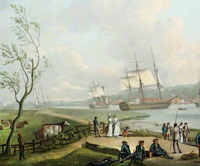
Photo from wikipedia
We measured the magnitude of submarine fresh groundwater discharge (SFGD) and associated nutrient inputs to Jocheon harbor, on Jeju Island, Korea, during four sampling periods, in order to determine the… Click to show full abstract
We measured the magnitude of submarine fresh groundwater discharge (SFGD) and associated nutrient inputs to Jocheon harbor, on Jeju Island, Korea, during four sampling periods, in order to determine the link between SFGD and Ulva sp. green tide development. Good correlations among salinity, 222Rn, and dissolved inorganic nitrogen (DIN) in harbor seawater suggest that SFGD is the major source of DIN and fresh water since there are no surface runoffs. Using a 222Rn mass balance model, SFGD to the harbor was estimated to be 5.8 ± 2.3 × 104 m3 d−1. The DIN inputs through SFGD enhanced DIN concentrations in harbor seawater approximately 10-fold of those in the open-ocean (outer harbor) seawater. Results from mesocosm experiments showed that the growth rate of U. pertusa increased by 160% on average due to the enhanced DIN concentrations (from 1 to 24 µM) through SFGD in this harbor. Thus, we conclude that DIN inputs through SFGD cause the green tide development in Jocheon harbor and perhaps in other green tide regions where river inputs are absent.
Journal Title: Scientific Reports
Year Published: 2017
Link to full text (if available)
Share on Social Media: Sign Up to like & get
recommendations!